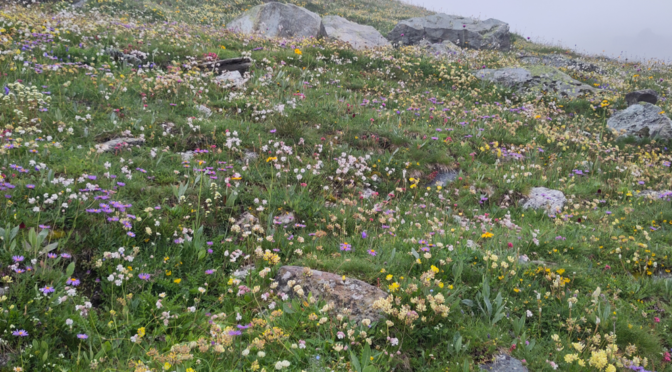Response Doctoral Program
Most insects that interact with plants have preferences for certain chemical components in the material they consume. In the case of insect herbivores and pollinators, both groups often need specific nutrients, or the avoidance of compounds that are toxic for them. As a consequence, they have evolved preferences or aversions to specific plant compounds, which guide their foraging for food sources.
To give some examples, the scent of flowers often attracts pollinators that effectively facilitate plant reproduction, while other compounds produced by the plant can be deterrents for particular insect herbivores. Far from being an exception, this kind of chemically mediated interaction is commonplace in nature, and it is one of the main objects of study of chemical ecology. Although much knowledge has been generated from studying interactions between two or three species of plants and insects at a time, we have a much less clear knowledge of communication in assemblages of species (ecological communities). Indeed, plants and insects have evolved within ecological communities, where communication towards multiple organisms occurs simultaneously, and where it shapes the networks of interactions that are developed among species. Understanding chemical communication at the community level could reveal new insights into the stability of ecosystems, and conservation of biodiversity.
Roberto Rebollo Hernandez is a PhD student at the Department of Environmental Systems at ETH Zurich, as well as a RESPONSE fellow in the PhD program Science and policy. In his research, conducted as part of the Information Ecology group lead by Pengjuan Zu, Roberto is studying how chemical communication shapes interaction networks between plants and pollinators in the alpine grasslands of Calanda, Switzerland. Together with the Office for Nature and Environment from Grisons, he aims to translate the results of this research into actionable advice for the protection of alpine biodiversity.
The main aim of the study is to understand the patterns of chemical communication at the community level, where multiple questions remain open. For example, how do different types of chemical traits associate with one another (for example, flower colors and scent components), and how do they relate to the interactions with insects? And which chemical traits of flowers are important for the structure of observed interaction networks? The study is being conducted in two sites characterised as alpine grasslands, at an elevation of 1400 and 2000 meters, in Calanda, Switzerland. This research integrates the study of chemical traits of multiple flowering plants, by measuring the color of flowers with specialised equipment, and collecting samples of nectar, pollen, and scent to analyse and characterise their chemical composition. Additionally, the fieldwork included the recording of observations and sampling of insect pollinators, to obtain the network of interactions between plants and insect pollinator species (Figure 1).

Research Findings
This research project is ongoing, and some preliminary results are available. For example, it was evaluated whether the concentration of individual components in nectar was different between the two plant communities. It was found that the proportion of sucrose in nectar was higher in the lower elevation (Figure 2 A). This result may be related to a different pollinator community across elevations, or abiotic factors (e.g., temperature and water availability). Evidence of a potential link to pollinators comes from the relationship between sucrose concentration in nectar and visits by pollinator groups, particularly bees (Figure 2 B). Preliminary analysis detected a contrasting concentration of a few other metabolites between elevations. The potential role of those compounds is currently under investigation. Overall, the results hint that some nectar traits are different across elevations and suggest potential links to the pollinator community.

Looking at flower color diversity, Roberto tested whether co-flowering plant communities have higher color diversity than expected by chance, and which biotic and abiotic factors are linked to the community color diversity. These questions were evaluated by incorporating flower spectral data (color), phytosociology, phenology, and abiotic traits, as well as models for insect color vision. Preliminary results showed that some co-flowering communities have a higher color diversity than expected by chance, while others have lower diversity. This diversity is dependent on the phenology of plant communities (Figure 3). Additionally, it was found that within some communities, flowers with more contrasting colors have a more contrasting composition of associated pollinators. In separate tests, some color components were also found to be associated with visits by certain pollinator groups. Overall, these results suggest that insect pollinators may play a role not only in shaping the color of individual flower species, but also in shaping the diversity of colors in some alpine co-flowering communities.

Societal Relevance of Research Findings
Alpine grasslands are hotspots of biodiversity in Europe and are vulnerable to climate change and land use change. Integrating trait-based data to interaction networks is a promising approach to design more targeted conservation practices, yet their application is only slowly emerging. Through this case study based in the Calanda grasslands, Roberto aims to generate insights into the key traits and/or pollinator groups in maintaining the structure of stability of the whole plant and pollinator communities.
Secondment
During the experiences facilitated by secondment in the Office for Nature and Environment of Grisons, Roberto was able to learn about the social context of alpine grasslands and their management. As a result of the secondment, a fact sheet was created outlining how chemical traits shape plant-pollinator networks and their potential for informing conservation.

Roberto Rebollo Hernandez is a fellow of the RESPONSE Doctoral Program (DP) «RESPONSE – to society and policy needs through plant, food and energy sciences» funded by the European Union’s Horizon 2020 research and innovation program under the Marie Skłodowska-Curie Grant Agreement No 847585.
This article is authored by Roberto Rebollo Hernandez.

